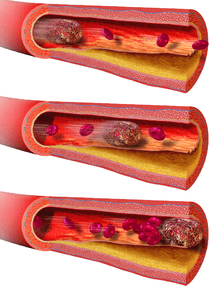Embolus
An embolus (/ˈɛmbələs/;[1] plural emboli; from the Greek ἔμβολος "wedge", "plug") is an unattached mass that travels through the bloodstream and is capable of clogging arterial capillary beds (create an arterial occlusion) at a site distant from its point of origin.[2] There are a number of different types of emboli, including blood clots, cholesterol plaque or crystals, fat globules, gas bubbles, and foreign bodies.

By contrast, there are non-traveling blockages that develop locally from vascular trauma or epithelial pathology and vascular inflammation — such as atheromata and thrombi. However, if a thrombus breaks loose from its genesis site it becomes a thrombo-embolus and if not broken down during transit, may cause embolism(s).[3]
The term was coined in 1848 by Rudolf Virchow.[4]
Classification by substance
- Thromboembolism – embolism of thrombus (blood clot).
- Cholesterol embolism – embolism of cholesterol, often from atherosclerotic plaque inside a vessel.
- Fat embolism – embolism of bone fracture or fat droplets.
- Air embolism (also known as a gas embolism) – embolism of air bubbles.
- Septic embolism – embolism of bacteria-containing pus.
- Tissue embolism – embolism of small fragments of tissue.
- Foreign body embolism – embolism of foreign materials such as talc and other small objects.
- Amniotic fluid embolism – embolism of amniotic fluid, foetal cells, hair, or other debris that enters the mother's bloodstream via the placental bed of the uterus and triggers an allergic reaction.
In thromboembolism, the thrombus (blood clot) from a blood vessel is completely or partially detached from the site of thrombosis (clot). The blood flow will then carry the embolus (via blood vessels) to various parts of the body where it can block the lumen (vessel cavity) and cause vessel obstruction or occlusion. The free-moving thrombus is called an embolus.[5] A thrombus is always attached to the vessel wall and is never freely moving in the blood circulation. This is also the key difference for pathologists to determine the cause of a blood clot, either by thrombosis or by post-mortem blood clot. Vessel obstruction will then lead to different pathological issues such as blood stasis and ischemia. However, not only thromboembolism will cause the obstruction of blood flow in vessels, but also any kind of embolism is capable of causing the same problem.
Fat embolism usually occurs when endogenous (from sources within the organism) fat tissue escapes into the blood circulation. The usual cause of fat embolism is therefore the fracture of tubular bones (such as the femur), which will lead to the leakage of fat tissue within the bone marrow into ruptured vessels. There are also exogenous (from sources of external origin) causes such as intravenous injection of emulsions.
An air embolism, on the other hand, is usually always caused by exogenic factors. This can be the rupture of alveoli, and inhaled air can be leaked into the blood vessels. Other more-common causes include the puncture of the subclavian vein by accident or during operation where there is negative pressure. Air is then sucked into the veins by the negative pressure caused by thoracic expansion during the inhalation phase of respiration. Air embolism can also happen during intravenous therapy, when air is leaked into the system (however this iatrogenic error in modern medicine is extremely rare).
Gas embolism is a common concern for deep-sea divers because the gases in human blood (usually nitrogen and helium) can be easily dissolved at higher amounts during the descent into deep sea. However, when the diver ascends to the normal atmospheric pressure, the gases become insoluble, causing the formation of small bubbles in the blood. This is also known as decompression sickness or the bends. This phenomenon is explained by Henry's Law in physical chemistry.
Embolism by other materials is rare. Septic embolism happens when a purulent tissue (pus-containing tissue) is dislodged from its original focus. Tissue embolism is a near-equivalent to cancer metastasis, which happens when cancer tissue infiltrates blood vessels, and small fragments of them are released into the blood stream. Foreign-body embolism happens when exogenous—and only exogenous—materials such as talc enter the blood stream and cause occlusion or obstruction of blood circulation. Bullet embolism occurs in approximately 0.3% cases of gunshot wounds.[6] Amniotic-fluid embolism is a rare complication of childbirth.
See also
References
- "embolus". Oxford English Dictionary (3rd ed.). Oxford University Press. September 2005. (Subscription or UK public library membership required.)
- Kumar V.; Abbas A.K.; Fausto N. Pathologic Basis of Disease.
- http://www.medterms.com/script/main/art.asp?articlekey=3224
- Hellemans, Alexander; Bryan Bunch (1988). The Timetables of Science. New York, New York: Simon and Schuster. pp. 317. ISBN 0-671-62130-0.
- Howland, Richard D.; Mycek, Mary J. Pharmacology. Lippincott's illustrated reviews (3rd ed.). Philadelphia : Lippincott Williams & Wilkins, c2006. p. 227. ISBN 0-7817-4118-1.
- http://www.jvascsurg.org/article/S0741-5214%2810%2902639-X/abstract